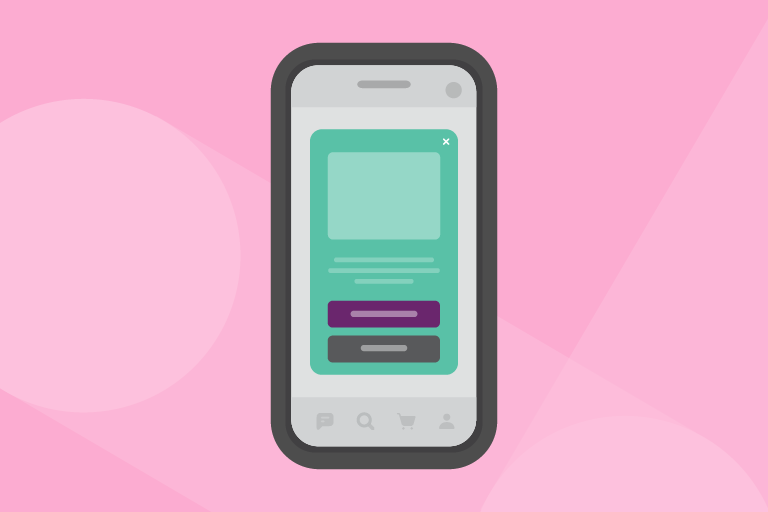In-app messages are targeted messages or notifications that pop up while someone is using an app. These messages are triggered by a specific action the user takes in the app. For example, a welcome message might appear when a user opens an app for the first time.
The idea behind in-app messaging is to grab the viewer’s attention to drive deeper engagement and encourage retention—which is important considering app retention rates drop over time. At the 30-day mark apps have a 66% retention rate, at the 90-day mark it dips to 48%. You can encourage interaction and deliver more value from your app by using in-app messaging to promote new app features or products, assist with onboarding, or provide updates on recent purchases.
Because in-app messaging can be used to send timely, targeted, and informative messages that drive users to take action, they are compared to push notifications. The major difference is that in-app messaging appears when the user is actively using the app, whereas push notifications pop up outside app use and are designed to bring the user into the app. In-app messaging can also be more timely since they’re often a direct response to user behavior. For example, if a customer is browsing a particular product page within your app, you might send an in-app notification offering them a 24-hour discount on that product, or alerting them that stock is low.
When to Use In-App Messaging
There are many ways that in-app messaging can deliver value to your users. Some of the most common and beneficial uses include:
- Onboarding: In-app messaging can be a great way to guide people through your app’s features, help them set up a profile, or turn on location services.
- Recognition: Gamification and rewards can help build loyalty to your app. For example, you might send users a badge when they complete a portion of their profile.
- In-app purchases: In-app messages are natural vehicles for offering new product promotions, deals, and coupons that drive in-app purchases.
- App updates: Layout or functionality updates and new features are things that users want to hear about. You can use in-app messaging to alert them to these changes as soon as they open the app.
- Collecting feedback: In-app messaging is a great way to get immediate feedback through surveys or ratings, and to encourage users to leave starred reviews on other platforms.
Best Practices for In-App Messaging
In general, the best in-app messages are short, engaging, and simple. You can dress up the text in your notifications with links, images, and even GIFs. In cases where you may need to send a longer message, you can use an interactive carousel feature to allow the user to rotate through the notifications.
Although many in-app messages are promotional, they should be helpful. After all, you want to encourage users to visit your app more often. To be sure your messages are more helpful than harmful, consider the timing. You don’t want to send pop-up messages when users are in the middle of a task in your app, like filling out a survey.
To test that your messages are resonating with your intended audience, use A/B testing as you would with other marketing efforts. When done well, in-app messaging can mean the difference between a user finding your app beneficial and easy to use, and deleting it off their phone.
Benefits of Using In-App Messaging
One of the top benefits of in-app messaging is its ease. Unlike push notifications, users don’t have to opt-in to get the messages. That means the potential audience for these messages is every user of your app. In-app messages also stand out more because people only see them when they’re using your app, versus the dozens of push notifications they receive from all of their downloaded apps throughout the day.
Targeted in-app messaging can provide a lot of added value to your user, and take pressure off certain aspects of your business, such as customer service. For example, you can use in-app messaging to alert people when a product is back in stock, or to offer real-time price drop announcements.
In-app messaging can be easily integrated into your app and is a simple tool to use. Most importantly, relevant and timely in-app messaging can help improve return on investment by boosting app satisfaction and conversion rates.
In-App Messaging as Part of a Cross-Channel Marketing Campaign
In-app messaging can be used as one valuable component of a comprehensive cross-channel marketing campaign.
For instance, if your hospitality brand is promoting a discount on a multi-night stay, you might launch a campaign that incorporates an email promotion, an SMS message, a push notification, and an in-app message, customizing your channel optimization for each customer based on the channels they use and how they respond to the offer across each platform. By engaging with your customers across the channels they are most likely to use, you’ll increase the chances they consider your offer and, ultimately, book a trip.
By using a sophisticated cross-channel marketing solution like Iterable, you’ll be able to get a 360-degree view of each customer and develop the right engagement strategy for each one of them, incorporating in-app messaging alongside other marketing channels to find the right way to connect with them.
Schedule a demo to learn more.
































